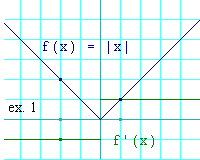

The absolute value function is the prototype function with a cusp. We
will be using it later in another problem in order to make it have a
cusp as well.
Here is a graph of  Nowhere is it true that
Nowhere is it true that
The rule for determining whether it is a maximum or a minimum is very similar to the rule at stationary points. If the discontinuity in f'(x) is increasing, then the cusp is a minimum. If the discontinuity is decreasing, then the cusp is a maximum. In this case, we can see it is increasing (that is, going from -1 to +1 as x increases) and hence a minimum of f(x).
That takes care of the minimum at the cusp. But the problem, as it is
written, also defines end points. It states that we should concern ourselves
only with the interval of
f(-2) = 2 f'(-2) = -1
f(1) = 1 f'(1) = 1
Here's the rule for endpoints: On a right-hand endpoint (that
is an upper limit on x), if the derivitative is
positive there, then the endpoint is a local maximum. If the
derivative is negative there, then the endpoint is a local
minimum.
In this problem, the right-hand endpoint is at
For a left-hand endpoint (that is a lower limit on x),
the rule is just the opposite. If the derivative there is negative,
then the endpoint is a local maximum. If the derivative there is
positive, then the endpoint is a local minimum.
In this problem, the left-hand endpoint is at
This still leaves open the problem of what to do if the derivative, f'(x), is zero at an endpoint. It gets a little complicated here. Here is the complete decision tree for deciding endpoints:
left end right end
| |
| find f'(endpoint) |
/|\ /|\
/ | \ / | \
/ | \ / | \
positive zero negative positive zero negative
it's a min | it's a max it's a max | it's a min
| |
| if f'(endpoint) = 0, |
| take higher derivatives |
| at the endpoint until |
| you get one that's not |
| equal to zero |
/ \ / \
/ \ / \
/ \ / \
positive negative positive negative
it's a min it's a max / \ / \
/ \ / \
/ \ / \
derivative number even or odd? even odd even odd
it's a min it's a max it's a min
And if it is clear that all derivatives are zero at
the endpoint, then the endpoint is neither a maximum nor a minimum.
For example, a step function, such as the one we discussed here, where
Chances are that you won't have to do any higher-derivative decisions on the exam, but just in case, now you know.
email me at hahn@netsrq.com